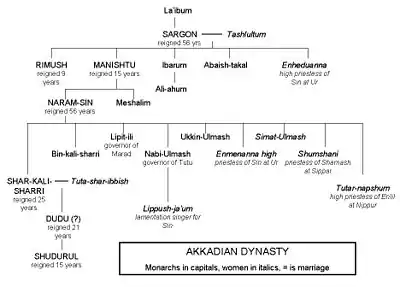| Dudu | |
|---|---|
 "Dudu the Great King of Akkad" 𒁺𒁺 𒁕𒈝 𒈗 𒀀𒂵𒉈𒆠 du-du da-num lugal a-ga-de3{ki} on an alabaster vase fragment, Louvre Museum AO 6773.[1] | |
| King of the Akkadian Empire | |
| Reign | c. 2189 BC – 2169 BC |
| Predecessor | Ilulu |
| Successor | Shu-turul |
| Issue | Shu-turul |
Dudu (Sumerian: 𒁺𒁺, du-du) was a 22nd-century BC king of the Akkadian Empire, who reigned for 21 years c. 2189-2169 BC according to the Sumerian king list. Unlike his two predecessors Naram-Sin and Shar-Kali-Sharri he was not deified.[2]
Biography
He became king after a period of apparent anarchy that had followed the death of Shar-Kali-Sharri.[3] The king list mentions four other figures who had been competing for the throne during a three-year period after Sharkalisharri's death. There are no other surviving records referencing any of these competitors, but a few artifacts with inscriptions confirming Dudu's rule over a reduced Akkadian Empire. Given activity at Umma and Girsu, and at Apiak whose location is unknown but which lay near the Tigris river to the East of Nippur, the Akkadian Empire maintained some level of control to the south at least. The find of a seal at Adab, lying further East that Apiak, of a servant of Dudu supports this view.[4] His inscriptions present him simply as "King of Akkad":
"Dudu the mighty, king of Agade: Amar-šuba the scribe (is) his servant."
He also seems to have campaigned against former Akkadian subjects to the south, including Girsu, Umma (where the governor of Lagash appointed by Shar-Kali-Sharri, Puzer-Mama, had declared independence at the end of that rule) and possibly Elam.[7][8] One inscription relates directly to his destruction of Girsu:
"To {d}inanna Ištar, Dudu, king of Agade, when Girsu he smote, from the booty of Girsu he dedicated it."
An alabaster vase in the Louvre Museum, since the year 2000,[10][11] has the following inscription:[12]
𒁺𒁺 𒁕𒈝 𒈗 𒀀𒂵𒉈𒆠 𒀀𒈾 𒀭𒊊𒀕𒃲 𒀀𒉈𒀝𒆠 𒀀𒈬𒊒 du-du da-num lugal a-ga-de3{ki} a-na {d}ne3-iri11-gal a-pi5-ak{ki} a mu-ru
"Dudu, the Great king of Akkad, for Nergal of Apiak has dedicated this"
Dudu was succeeded by his son Shu-turul per the king list, who became the last known king of the Akkadian Empire. It has been suggested that a known high official in the Late Akkadian period, Išarum, was another son of Dudu. In inscriptions he calls himself "Išarum, son of Dudu" and calls on the tutelary gods of the Akkadian Empire, Istar and Ilaba.[17]
.jpg.webp) "Dudu, Great King of Akkad" (𒁺𒁺 𒁕𒈝 𒈗 𒀀𒂵𒉈𒆠, Du-du da-num lugal a-ga-de3(ki)) on the Dudu alabaster vase.
"Dudu, Great King of Akkad" (𒁺𒁺 𒁕𒈝 𒈗 𒀀𒂵𒉈𒆠, Du-du da-num lugal a-ga-de3(ki)) on the Dudu alabaster vase.
 Dudu in the Akkadian family tree
Dudu in the Akkadian family tree
See also
Sources
- ↑ Thureau-Dangin, F. (François) (1918). La chronologie des dynasties de Sumer et d'Accad. Paris : Leroux. p. 63.
- ↑ Steinkeller, Piotr, "The Divine Rulers of Akkade and Ur: Toward a Definition of the Deification of Kings in Babylonia", History, Texts and Art in Early Babylonia: Three Essays, Berlin, Boston: De Gruyter, pp. 107-157, 2017
- ↑ The first great civilizations: life in Mesopotamia, the Indus Valley, and Egypt by Jacquetta Hopkins Hawkes
- ↑ "CDLI-Found Texts". cdli.ucla.edu.
- 1 2 3 Douglas R. Frayne, "Akkad", The Sargonic and Gutian Periods (2334-2113), pp. 5-218, University of Toronto Press, 1993, ISBN 0-8020-0593-4
- ↑ "CDLI-Archival View". cdli.ucla.edu.
- ↑ Foster, Benjamin R ., ""International“ Trade at Sargonic Susa (Susa in the Sargonic Period III)", Altorientalische Forschungen, vol. 20, no. 1, pp. 59-68, 1993
- ↑ Gwendolyn Leick, "Who's Who in the Ancient Near East", 2002
- ↑ "CDLI-Archival View". cdli.ucla.edu.
- ↑ "Site officiel du musée du Louvre". cartelfr.louvre.fr.
- ↑ Formerly Collection Jean-Philippe Mariaud de Serres "CDLI-Archival View". cdli.ucla.edu.
- ↑ Delaporte, L. (2013). Mesopotamia. Routledge. p. 32. ISBN 978-1-136-19924-0.
- ↑ "Site officiel du musée du Louvre". cartelfr.louvre.fr.
- ↑ "CDLI-Archival View". cdli.ucla.edu.
- ↑ "Site officiel du musée du Louvre". cartelfr.louvre.fr.
- ↑ "CDLI-Archival View". cdli.ucla.edu.
- ↑ Kraus, Nicholas, "The Weapon of Blood: Politics and Intrigue at the Decline of Akkad", Zeitschrift für Assyriologie und vorderasiatische Archäologie, vol. 108, no. 1, pp. 1-9, 2018
- ↑ "CDLI-Archival View". cdli.ucla.edu.

